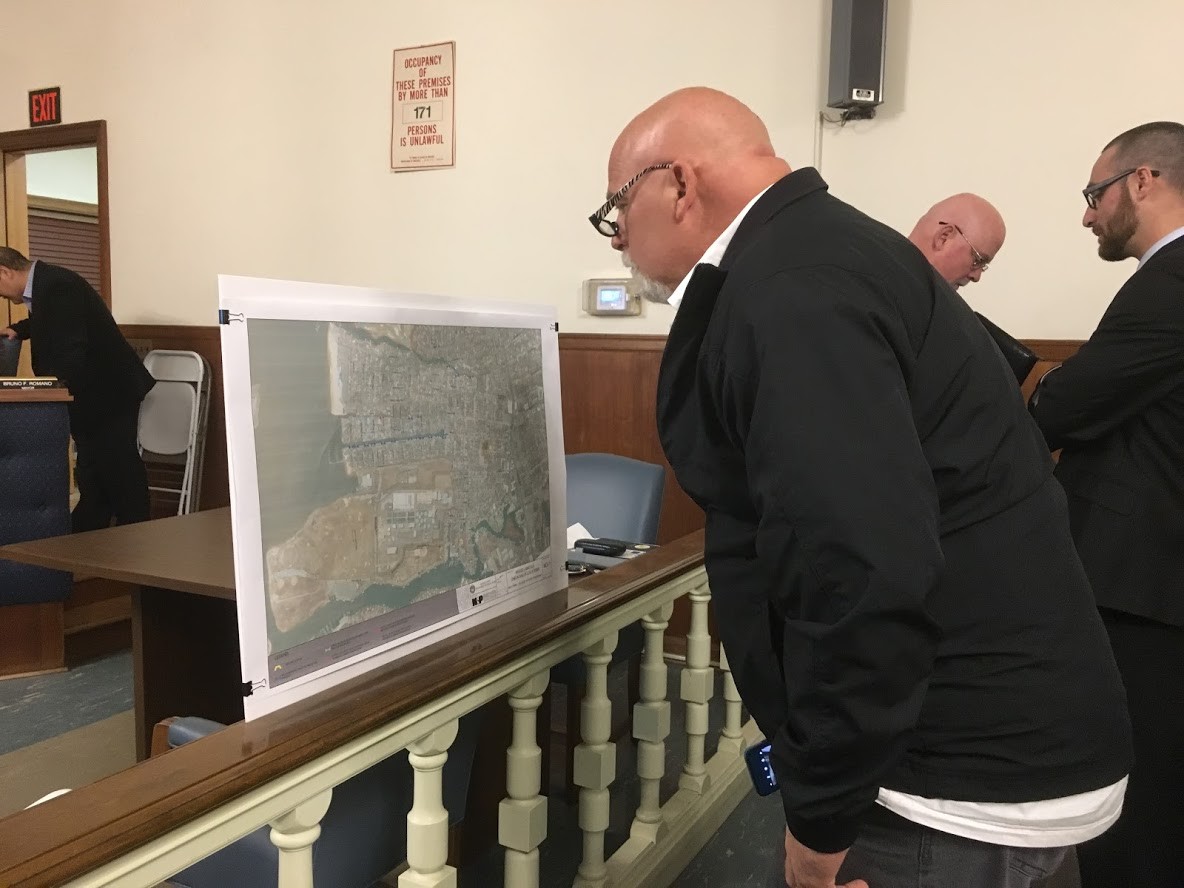Flooded Bay Park residents express concerns with GOSR’s pipe plan
Every month at high tide, when the moon is full, Bay Park resident Lenny Fiorentino wades through three to five inches of water to bring his children to day care. If a car passes while Fiorentiono is strapping his 1-year-old and 4-year-old in, water can splash as high as four feet, right onto him. If a high tide occurs on garbage day, Fiorentino also has to pick up the trash strewn across his front lawn, he said.
To improve the situation, the New York State Governor’s Office of Storm Recovery proposed at a March 30 hearing to install 18 check valves on the pipes under West, East and North boulevards in Bay Park. The valves are flaps in the pipes that close as water rises to prevent it from flowing the wrong way, so it returns to ground level.
Fiorentino and other Bay Park residents, however, do not think the valves would help their situation. “I think this is all smoke and mirrors,” Fiorentino said. “I don’t think things are being done.”
According to Fiorentino, the problem is that the pipes are full of holes, and therefore redirect the water back to the drains. “The drains aren’t being maintained there,” he said. “They’re broken. They’re collapsing.”
The pipes are supposed to be maintained by the municipality that installed them — the Village of East Rockaway, the Town of Hempstead or Nassau County. Before a plan is implemented, the municipalities must determine who owns the pipes and fix them before valves are installed. At last week’s hearing, Sean Sallie, the planning supervisor for Nassau County’s Planning Department, said that construction on the pipes was tentatively scheduled for next spring.
Russell Scott, a partner at Nelson & Pope Engineers & Surveyors, who worked with GOSR to develop the plan, said that the engineers would consider the condition of a pipe before installing check valves. “We’re not putting a check valve on a broken piece of pipe,” he said at the hearing. “That makes no sense.”
After sending an observation team to monitor area flooding after each storm, GOSR decided that check valves would be the most cost-effective solution for Bay Park. It also used a computer program to calibrate how the area would deal with flooding in different storms. Sallie acknowledged that the process is not perfect. “The pipes that are in the ground, you can’t see them, obviously,” he said. “So you have to make a few assumptions.”
In the end, Nelson & Pope came up with about 20 different projects, but had only $5.5 million from a community block grant that New York received after Hurricane Sandy. A total of $6.5 million was allocated to cover East Rockaway and Bay Park, $5.5 million of which was dedicated to construction for the project, which is called the New York Rising Community Reconstruction project.
“When we estimated the costs, they were in the tens of millions,” Sallie said. “When you have the $5.5 million to spread throughout the entire village, check valves seemed to be the most cost-effective.” These would not protect Bay Park during a major storm, however. “It’s not a solution for a nor’easter,” Scott explained.
Bay Park residents were also frustrated that the village will benefit from a more expensive project on Lawson Avenue, where the drainage system is being replaced. Several Bay Park residents expressed concern that East Rockaway’s project might use a bigger chunk of the allocated $5.5 million. Calls to state officials about the cost of the East Rockaway project were not returned as of press time.
“After the second block on Lawson, it’s not flooded ever — ever,” one Bay Park man said, adding that he has to drive on Lawson every day to get to work. Construction for the project is scheduled to begin in the fall of 2018.
Scott replied that floods do not just occur on Lawson Avenue when there is a high tide. He said thet street is deluged whenever it rains. “We were out there during every storm event, and looked at it for six months,” he said.
Another state-sponsored group that implements long-range planning strategies and short-term projects, Living with the Bay, received $125 million from a community block grant, and might be able to help stabilize the area with part of those funds. The group’s Citizens Advisory Committee identified 42 flood-prone areas between Bay Park and Hempstead Lake Park. Three of these problem areas are in Bay Park.
At the hearing, Sallie said that he would provide the advisory committee with the data engineers collected to help the group decide which solutions would be the best options. The committee has not yet proposed solutions, nor has it allocated any money inOceanside, Rockville Centre, Lynbrook, East Rockaway, Malverne or Hempstead.
This story was updated on April 6 at 8:33 p.m. to correct the name of the office. It is New York State Governor's Office of Storm Recovery, not Nassau County Governor's Office of Storm Recovery.







